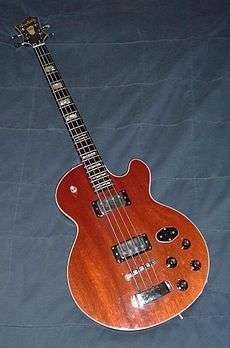Swede Patch 2000
| Swede Patch / Swede Patch 2000 | |
|---|---|
|
Hagström Patch 2000 Bass | |
| Manufacturer | Hagström / Ampeg |
| Period | 1976-1979 |
| Construction | |
| Body type | Solid single cutaway |
| Neck joint |
Set neck H-Expander truss rod |
| Scale | 24,75“ / 629 mm |
| Woods | |
| Body | Mahogany |
| Neck | Mahogany |
| Fretboard | Resonator Wood with dot inlays and extra high frets |
| Hardware | |
| Bridge |
Isolated Long Travel Tune-O-Matic |
| Pickup(s) | 2 x Hagström original pickups developed and produced in Sweden |
| Colors available | |
| Natural mahogany. | |
The Hagström Swede Patch 2000 is the first guitar/synthesizer hybrid. It was manufactured by Hagström in collaboration with Ampeg. The guitar appears to be a normal Hagström Swede but the neck is specially wired to transmit an input to a synthesizer when the strings come in contact with the frets. This gives the player the option of playing the instrument as a guitar, as a synthesizer or a combination of both.
Development
Preparations for the development started in 1975 when twelve guitars were to be finished for a music convention. In April the same year Hagström received the electronics provided by Ampeg who were the supplier of the advanced electronics. The idea was to place a digital receiver within the body of the guitar that was controlled by a switch which selected between the traditional guitar sound and the synthesizer sound. If more than one string was used it automatically selected the highest fret and lowest string. The receiver was connected to the strings and frets, every string and fret had an own individual code. Due to this, each string had to be electrically isolated, this meant that Hagström had to develop a new tailpiece/bridge system. The newly developed bridge looks like a typical Hagström, except the centers of the saddles made of are dense plastic, not metal. Instead of 1 tailpiece each string terminates at a separate block set in 2 rows.
The PC inside the guitar received signals as soon as a string came in contact with a fret and the signal was sent through a special cable (the guitar was equipped with two outlets) to the Patch 2000 box. The Patch 2000 box was equipped with a pitch pedal that raises the pitch in semitone increments up to one full octave, a glide pedal that controls the portamento (the time it takes for the one note to change to another) and a Fifth Harmony Switch produces a tone seven semitones, or a natural 5th, above the note played. From the Patch-2000 box the signal was sent on to an analog synthesizer which turned the signal into musical tones. Synthesizers were not provided by the manufacturer. With the Patch 2000 in mind, the American synthesizer company Steiner-Parker (Steiner Synthesizers) developed and recently sold the Microcon,[1] a small micro synthesizer without the keyboard, but with all the facilities of a "big" synthesizer.
The guitar was tried by a test-panel which included Mick Box (Uriah Heep), Bob Welch and John McView who said that "It had very clear solo sounds, but the fact is that you couldn´t use chords, which is an integral part of your music…you can only use it just for solos." The triggering system was monophonic, a polyphonic consumer model was never produced. He supposedly also claimed it was very convenient since you could play it using only your left hand, which allowed you to drink beer with your free hand. A total of 498 right hand models were produced from 1976 to 1979 (the vast majority to Leo's Music, Don Weir and Guitar Center in the Bay Area and LA. 11 left-handed models based on the Hagström Swede were manufactured in 1977. There were also a small run of Swede and Jazz basses equipped with the Patch 2000 system.
References
- Patch 2000 Hagstrom.org.uk
- Swede Patch 2000 johnssailboat.com
- The Patch 2000 balgdraget.com
- citations
- ↑ "The Microcon". Musician, Player and Listener. Amordian Press (8): 6. 1977.
Steiner Synthesizers (formerly Steiner-Parker) gets there first -- as usual, with the introduction of the world's first "pocket" synthesizer, the Microcon. It makes the perfect accessory for your present equipment, ... It is also an ideal companion for a guitar slavedriver, Patch 2000, guitar synthesizer ...
